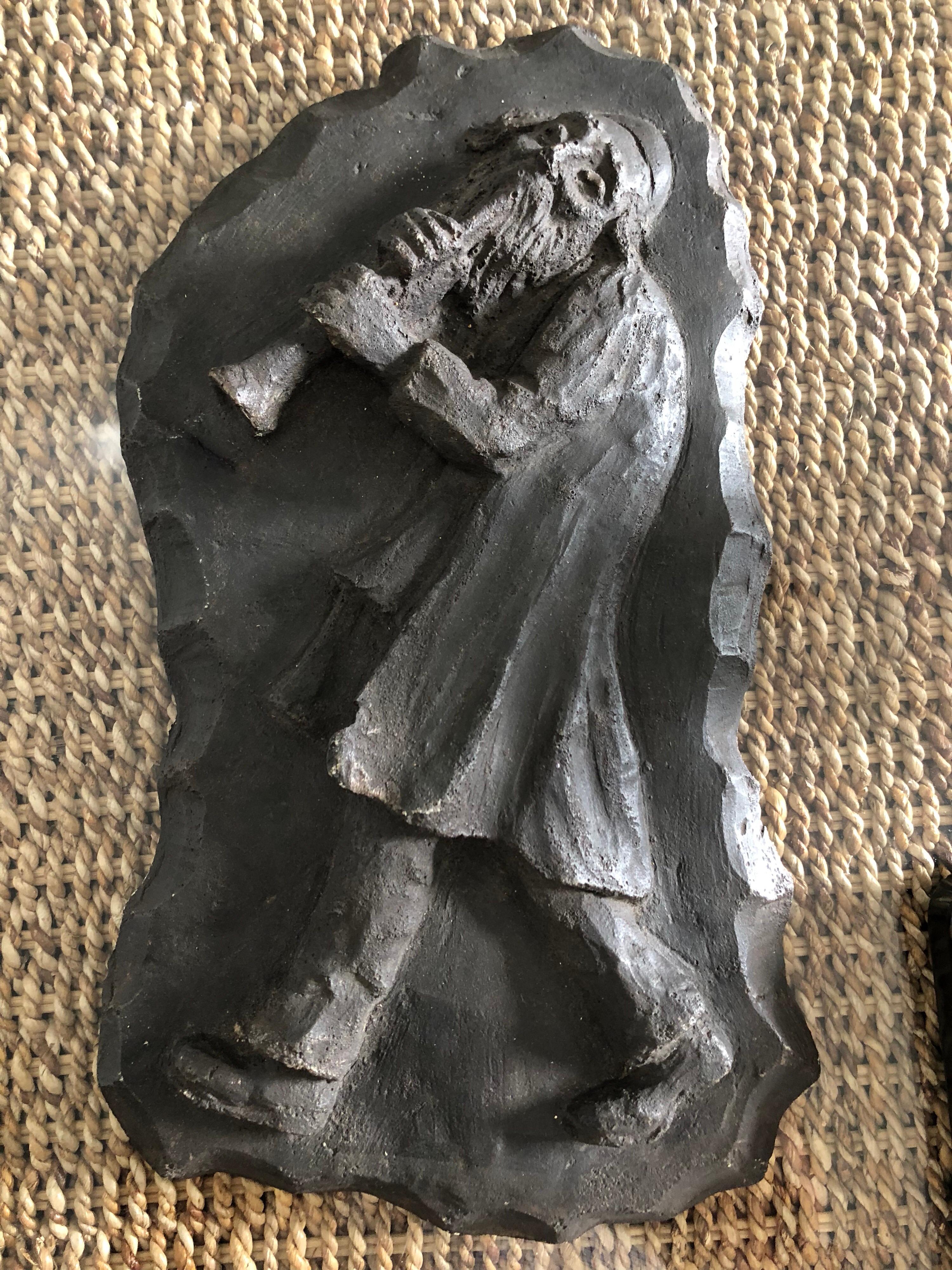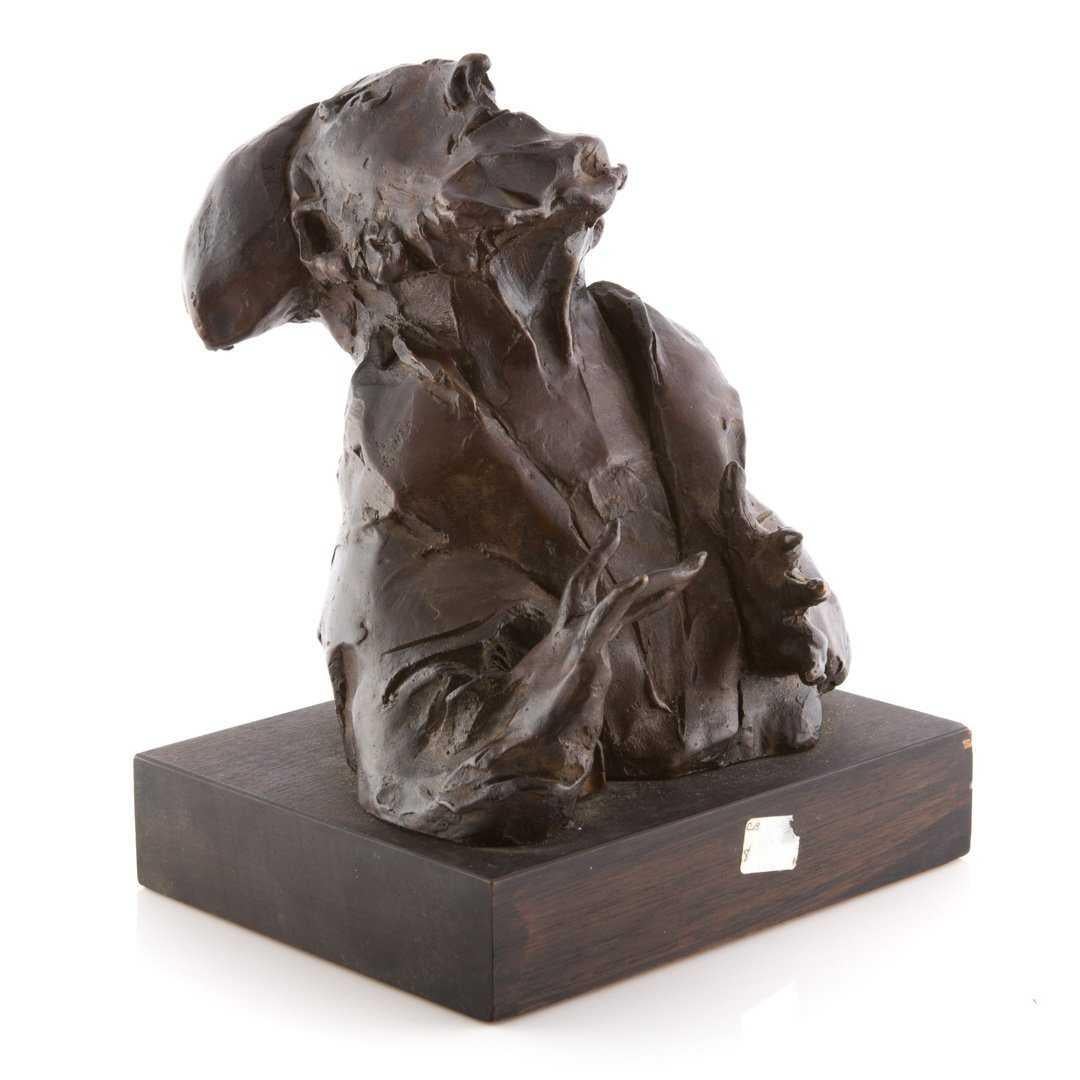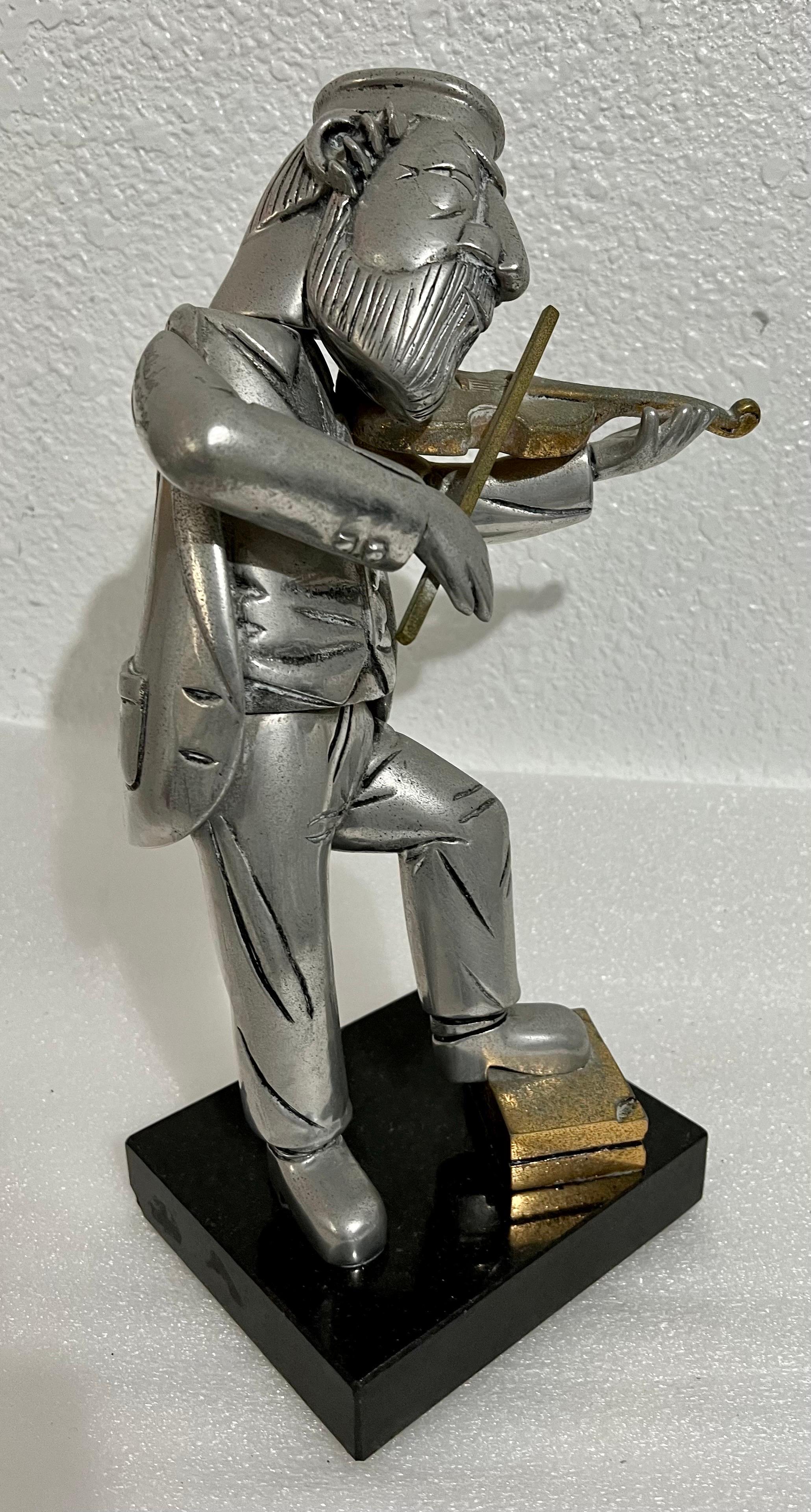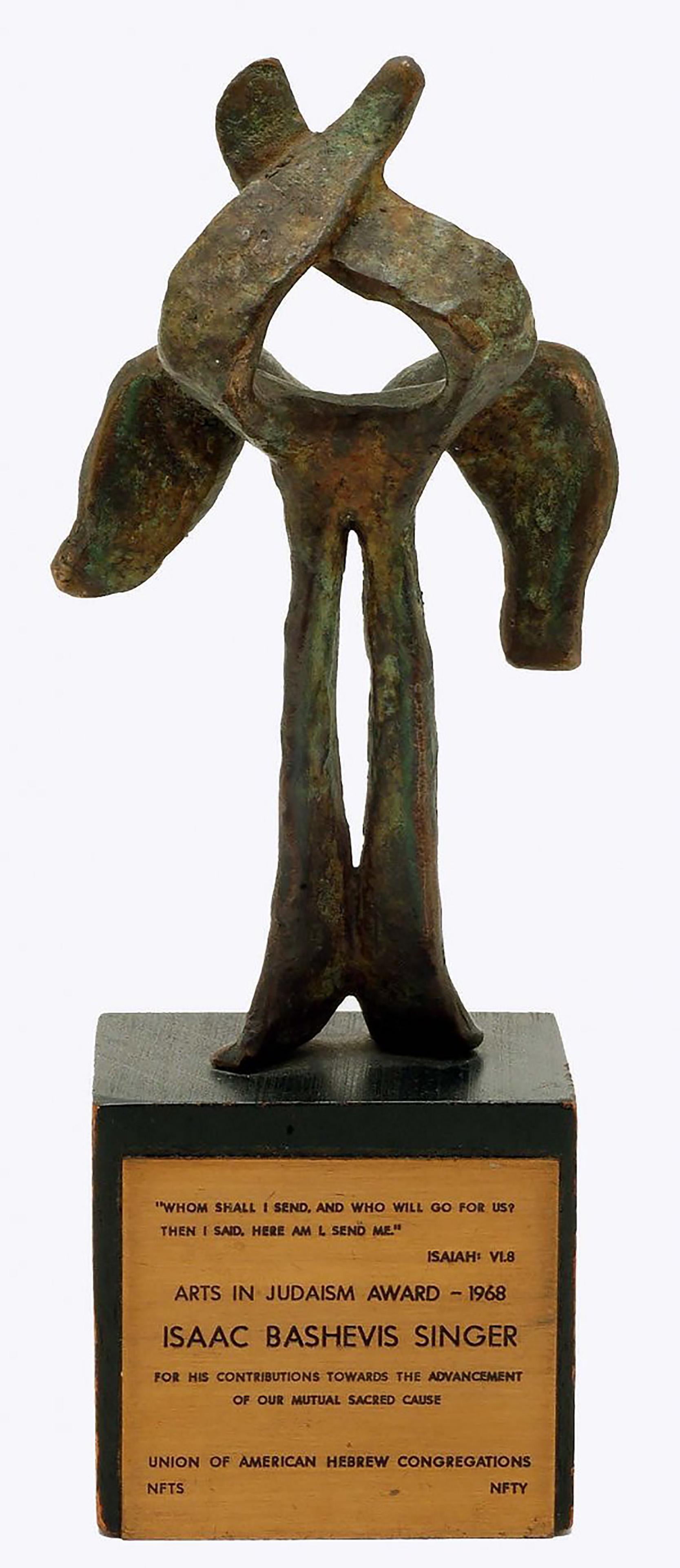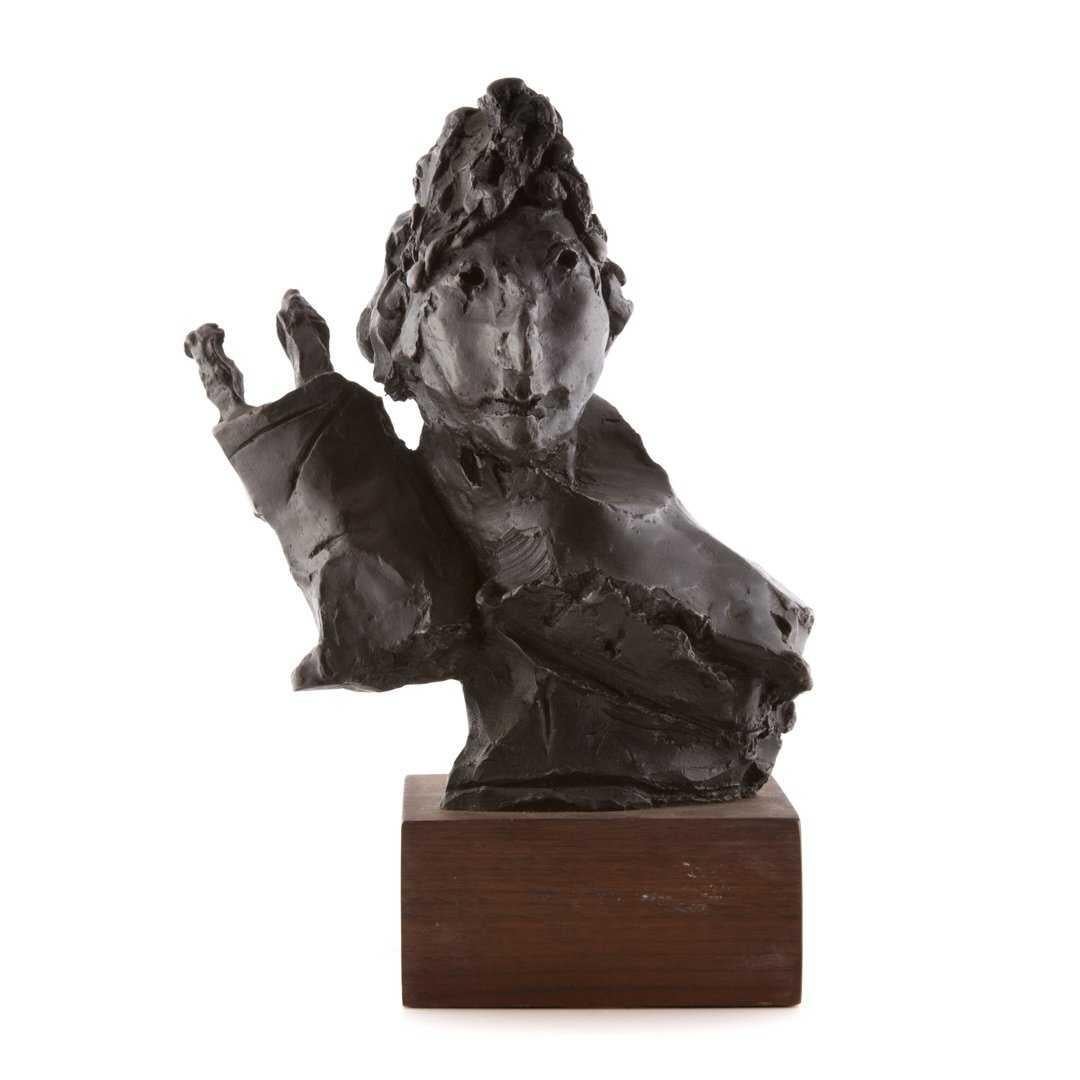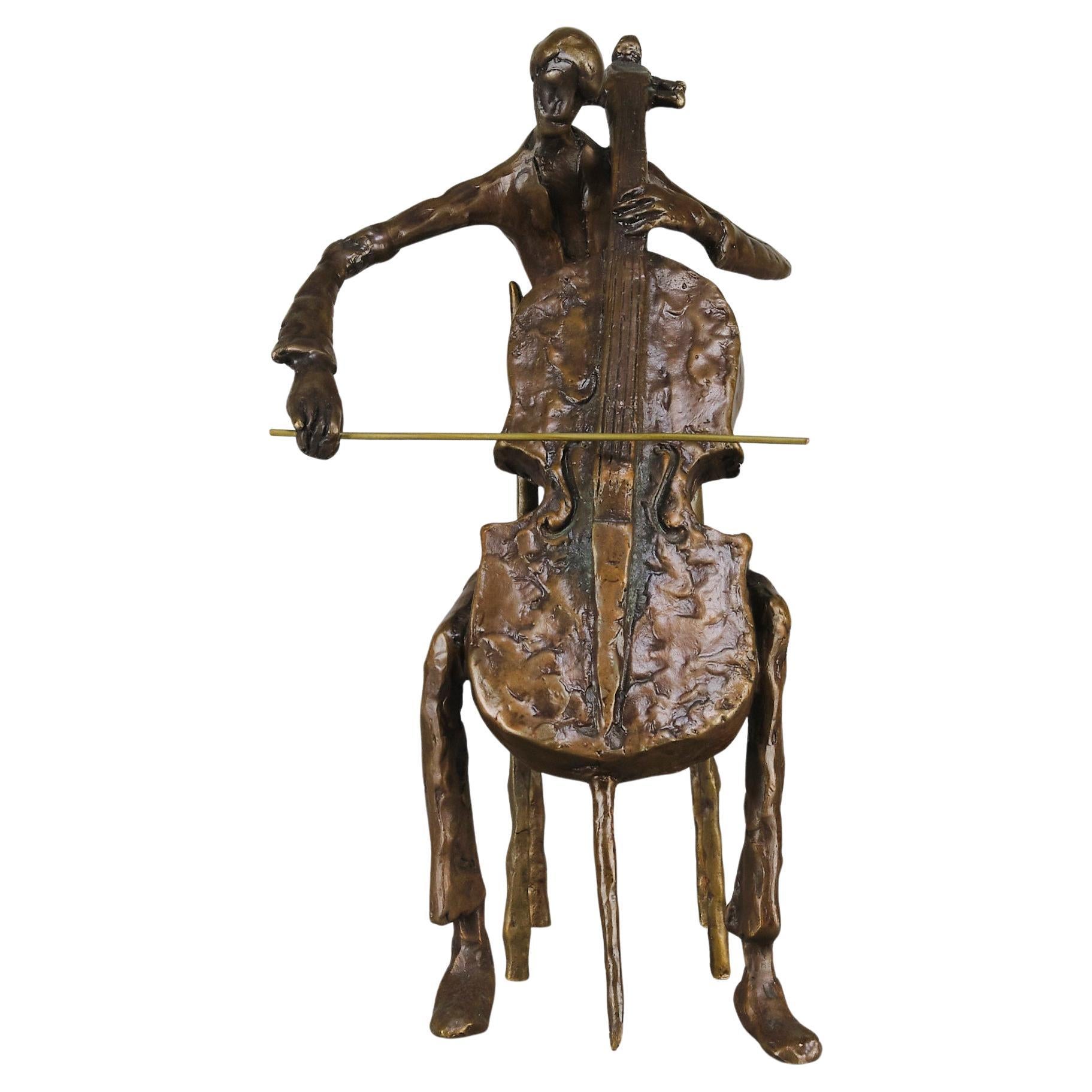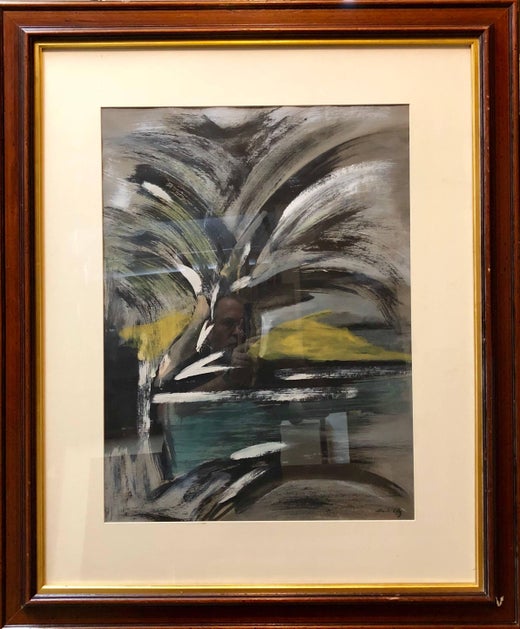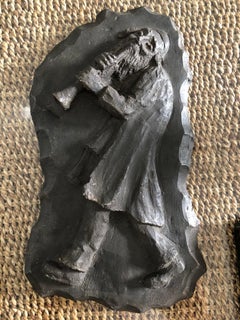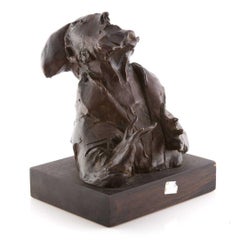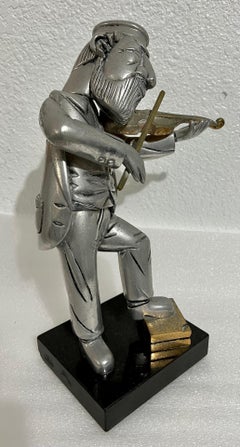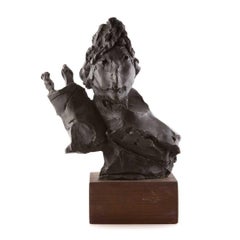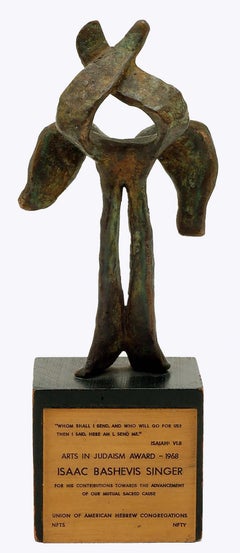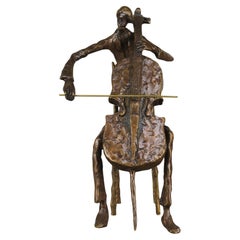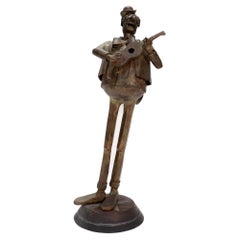Items Similar to Russian French Judaica Jewish Shtetl Wedding Klezmer Musician Bronze Sculpture
Want more images or videos?
Request additional images or videos from the seller
1 of 11
Mane KatzRussian French Judaica Jewish Shtetl Wedding Klezmer Musician Bronze Sculpture
$6,500
£4,969.60
€5,723.97
CA$9,108.49
A$10,168.78
CHF 5,328.29
MX$124,475.80
NOK 67,669.28
SEK 63,803.54
DKK 42,718.58
Shipping
Retrieving quote...The 1stDibs Promise:
Authenticity Guarantee,
Money-Back Guarantee,
24-Hour Cancellation
About the Item
Bronze Double Bass Player Klezmer Musician Sculpture signed Mane-Katz at base. Numbered 8/8.
-Katz (1894-1962) was a Litvak painter born in Ukraine best known for his depictions of the Jewish shtetl in Eastern Europe. Emmanuel Mané-Katz (Hebrew:מאנה כץ), born Mane Leyzerovich Kats (1894–1962), was a Litvak painter born in Kremenchuk, Ukraine, best known for his depictions of the Jewish shtetl in Eastern Europe. Particularly music figures and Jewish wedding scenes.
Mane-Katz moved to Paris at the age of 19 to study art, although his father wanted him to be a rabbi. During the First World War he returned to Russia, at first working and exhibiting in Petrograd; following the October revolution, he traveled back to Kremenchuk, where he taught art. In 1921, due to the ongoing fighting in his hometown during the civil war, he moved once again to Paris. There he became friends with Pablo Picasso and other important French artists, and was affiliated with the art movement known as the School of Paris; together with other outstanding Jewish artists of that milieu, he is sometimes considered to be part of a group referred to specifically as the Jewish School of Paris. Includes Russian, Ukrainian and Polish painters Jankel Adler, Arbit Blatas, Marc Chagall, Jacques Chapiro, Michel Kikoine, Pinchus Kremegne, Sigmund Menkes, Jules Pascin, Issachar Ryback, Jacques Lipchitz,Chana Orloff, and Ossip Zadkine. Ecole de Paris
In 1931, Mane-Katz's painting The Wailing Wall was awarded a gold medal at the Paris World's Fair. Early on, his style was classical and somber, but his palette changed in later years to bright, primary colors, with an emphasis on Jewish themes. His oils feature Judaic Hasidic characters, rabbis, Jewish musicians, beggars, yeshiva students and scenes from the East European shtetl made famous in the west by Sholem Aleichem and Tevye.
Mane-Katz made his first trip to Mandate Palestine in 1928, and thereafter visited the country annually. He said his actual home was Paris, but his spiritual home was Eretz Yisrael, the Land of Israel. In 1939, as World War II was breaking out, he was drafted by the French and then was taken prisoner by the Germans. He escaped and went to the United States and remained there until 1945, exhibiting his paintings at Katia Granoff Gallery and Wildenstein Gallery. After the war, he returned to Paris where he had exhibited in the Salons. In Paris to the end of his career, he worked happily, painting hundreds of portraits of rabbis and works of Jewish symbolism. In this way, it is thought he was to satisfy his father, who had wanted him to be a rabbi. During these last years, he also resumed intense travel, going to Brazil, Japan, Israel and Argentina as well as throughout Europe.
Mane-Katz left his paintings and extensive personal collection of Judaica ritual art to the city of Haifa, Israel. Four years before his death, the mayor of Haifa, Abba Hushi, provided him with a building on Mt. Carmel to house his work, which became the Mane-Katz Museum. The exhibit includes Mane-Katz's oils, showing a progressive change in style over the years, a signed portrait of the artist by Pablo Picasso dated 1932 and a large collection of Jewish ritual objects.
In 1953, Mane-Katz donated eight of his paintings to the Glicenstein Museum in Safed, whose artists quarter attracted leading Israeli artists in the 1950s and 1960s, and housed some of the country's most important galleries.
Mane Katz
Emmanuel Mané-Katz was a prominent modernist in Paris at the beginning of the twentieth century. He studied at the Beaux Arts Academy in Kyiv, Ukraine. After his extensive travels through Europe (catalyzed by World War I), Mané-Katz eventually settled in Paris, where he befriended Pablo Picasso and other fellow modernists. Many of Mané-Katz’s paintings have deep religious significance and origins, often picturing rabbis, Jewish students, and other Hassidic personas. Such paintings of Jewish folklore are often compared to Marc Chagall’s religiously-influenced art practice. He continued his travels to places like Israel, Palestine, Brazil, and Japan throughout the rest of his life, maintaining adherence to religious themes and portraiture in his art. The Mané-Katz Museum is located on Mt. Carmel in Haifa, Israel, and his work is part of the permanent collections of the Tate, the MOMA, and the Museum of Art at Ein Harod in Israel. After his death, Mané-Katz donated much of his art to Haifa, Israel, where his home was. His participation in the School of Paris alongside modernists like Picasso, Chagall, and Soutine solidified him as an influential modernist painter in the early twentieth century.
About the Seller
4.9
Platinum Seller
Premium sellers with a 4.7+ rating and 24-hour response times
Established in 1995
1stDibs seller since 2014
1,784 sales on 1stDibs
Typical response time: <1 hour
- ShippingRetrieving quote...Shipping from: Surfside, FL
- Return Policy
Authenticity Guarantee
In the unlikely event there’s an issue with an item’s authenticity, contact us within 1 year for a full refund. DetailsMoney-Back Guarantee
If your item is not as described, is damaged in transit, or does not arrive, contact us within 7 days for a full refund. Details24-Hour Cancellation
You have a 24-hour grace period in which to reconsider your purchase, with no questions asked.Vetted Professional Sellers
Our world-class sellers must adhere to strict standards for service and quality, maintaining the integrity of our listings.Price-Match Guarantee
If you find that a seller listed the same item for a lower price elsewhere, we’ll match it.Trusted Global Delivery
Our best-in-class carrier network provides specialized shipping options worldwide, including custom delivery.More From This Seller
View AllFrench Painted Maquette for Sculpture Judaica Klezmer Musician
By Mane Katz
Located in Surfside, FL
Mane-Katz (1894-1962) maquette plaster relief for bronze sculpture. (it is made from sort of composite material and then painted or colored from the casting. there is no foundry mar...
Category
20th Century Modern Figurative Sculptures
Materials
Plaster, Paint
Judaica Bronze Sculpture "Rabbi" Figure Jewish American Boston Figural Modernist
By David Aronson
Located in Surfside, FL
Aronson, David 1923-
David Aronson, son of a rabbi, was born in Lithuania in 1923 and immigrated to America at the age of five. He settled in Boston, Massachusetts where he studied at the school of the Museum of Fine Arts under Karl Zerbe, a German painter well known in the early 1900s. Aronson later taught at the school of the Museum of Fine Arts for fourteen years and founded the School of Fine Art at Boston University where he is today a professor emeritus. An internationally renowned sculptor & painter, Aronson has won acclaim for his interpretation of themes from the Hebrew Talmud and Kabala. His best known works include bronze castings, encaustic paintings, and pastels. His work is included in many important public and private collections, and has been shown in several museum retrospectives around the country. He is considered to be one of the most important 20th century American artists.
At twenty-two David Aronson had his first one-man show at New York's Niveau Gallery. The next year, six of his Christological paintings were included in the Fourteen Americans exhibition at Manhattan's Museum of Modern Art where Aronson’s work was included alongside abstract expressionists Arshile Gorky, Robert Motherwell and Isamu Noguchi. In the 1950s, Aronson turned more toward his Jewish heritage for the inspiration for his art. Folklore as well as Kabalistic and other transcendental writings influenced his work greatly. The Golem (a legendary figure, brought to life by the Maharal of Prague out of clay to protect the Jewish community during times of persecution) and the Dybbuk (an evil spirit that lodges itself in the soul of a living person until exorcised) frequently appear in his work.
In the sixties, Aronson turned to sculpture. His work during this period is best exemplified by a magnificent 8’ x 4’ bronze door which now stands at the entrance to Frank Lloyd Wright's Johnson Foundation Conference Center for the Arts in Racine, Wisconsin. In the seventies and eighties, Aronson continued his work in pastel drawings, paintings, and sculptures, often exploring religion and the frailties of man's nature. During this time, in addition to a traveling retrospective exhibition and many one-man shows in New York, Los Angeles, Chicago, and Boston at the Pucker-Safrai Gallery on Newbury Street, Aronson won many awards and became a member of the National Academy of Design in New York. Two years ago he retired from teaching to work full-time in his studio in Sudbury, Massachusetts.
included in the catalog
Contemporary Religious Imagery in American Art
Catalog for an exhibition held at the Ringling Museum of Art, March 1-31, 1974.
Artists represented: David Aronson, Leonard Baskin, Max Beckmann, Hyman Bloom, Fernando Botero, Paul Cadmus, Marvin Cherney, Arthur G. Dove, Philip Evergood, Adolph Gottlieb, Jonah Kinigstein, Rico Lebrun, Jack Levine, Louise Nevelson, Barnett Newman, Abraham Rattner, Ben Shahn, Mark Tobey, Max Weber, William Zorach and others.
Selected Awards
1990, Certificate of Merit, National Academy of Design
1976, Purchase Prize, National Academy of Design
1976, Joseph Isidore Gold Medal, National Academy of Design
1976, Purchase Prize in Drawing, Albrecht Art Museum
1975, Isaac N. Maynard Prize for Painting, National Academy of Design
1973, Samuel F. B. Morse Gold Medal, National Academy of Design
1967, Purchase Prize, National Academy of Fine Arts
1967, Adolph and Clara Obrig Prize, National Academy of Design
1963, Gold Medal, Art Directors Club of Philadelphia
1961, 62, 63, Purchase Prize, National Institute of Arts and Letters
1960, John Siimon Guggenheim Fellowship
1958, Grant in Art, National Institute of Arts and Letters
1954, First Prize, Tupperware Annual Art Fund Award
1954, Grand Prize, Third Annual Boston Arts Festival
1953, Second Prize, Second Annual Boston Arts Festival
1952, Grand Prize, First Annual Boston Arts Festival
1946, Traveling Fellowship, School of the Museum of Fine Arts
1946, Purchase Prize, Virginia Museum of Fine Arts
1944, First Popular Prize, Institute of Contemporary Art
1944, First Judge's Prize, Institute of Contemporary Art
Selected Public Collections
Art Institute of Chicago
Virginia Museum of Fine Arts
Bryn Mawr College
Brandeis University
Tupperware Museum, Orlando, Florida
DeCordova Museum
Museum of Modern Art Print Collection, New York
Atlanta University
Atlanta Art...
Category
20th Century Expressionist Figurative Sculptures
Materials
Bronze
Rare Vintage Israeli Judaica Rabbi Klezmer Violinist Sculpture Frank Meisler Art
By Frank Meisler
Located in Surfside, FL
Rare Vintage unusual piece.
In this bronze or metal sculpture by Frank Meisler, the artist depicts a Klezmer violin player The figure seems cartoon-like with exaggerated facial featu...
Category
1960s Folk Art Sculptures
Materials
Stone, Metal
Bronze Sculpture Rabbi w Torah Judaica Figure American Boston Figural Modernist
By David Aronson
Located in Surfside, FL
Aronson, David 1923-
David Aronson, son of a rabbi, was born in Lithuania in 1923 and immigrated to America at the age of five. He settled in Boston, Massachusetts where he studied at the school of the Museum of Fine Arts under Karl Zerbe, a German painter well known in the early 1900s. Aronson later taught at the school of the Museum of Fine Arts for fourteen years and founded the School of Fine Art at Boston University where he is today a professor emeritus. An internationally renowned sculptor & painter, Aronson has won acclaim for his interpretation of themes from the Hebrew Talmud and Kabala. His best known works include bronze castings, encaustic paintings, and pastels. His work is included in many important public and private collections, and has been shown in several museum retrospectives around the country. He is considered to be one of the most important 20th century American artists.
At twenty-two David Aronson had his first one-man show at New York's Niveau Gallery. The next year, six of his Christological paintings were included in the Fourteen Americans exhibition at Manhattan's Museum of Modern Art where Aronson’s work was included alongside abstract expressionists Arshile Gorky, Robert Motherwell and Isamu Noguchi. In the 1950s, Aronson turned more toward his Jewish heritage for the inspiration for his art. Folklore as well as Kabalistic and other transcendental writings influenced his work greatly. The Golem (a legendary figure, brought to life by the Maharal of Prague out of clay to protect the Jewish community during times of persecution) and the Dybbuk (an evil spirit that lodges itself in the soul of a living person until exorcised) frequently appear in his work.
In the sixties, Aronson turned to sculpture. His work during this period is best exemplified by a magnificent 8’ x 4’ bronze door which now stands at the entrance to Frank Lloyd Wright's Johnson Foundation Conference Center for the Arts in Racine, Wisconsin. In the seventies and eighties, Aronson continued his work in pastel drawings, paintings, and sculptures, often exploring religion and the frailties of man's nature. During this time, in addition to a traveling retrospective exhibition and many one-man shows in New York, Los Angeles, Chicago, and Boston at the Pucker-Safrai Gallery on Newbury Street, Aronson won many awards and became a member of the National Academy of Design in New York. Two years ago he retired from teaching to work full-time in his studio in Sudbury, Massachusetts.
included in the catalog
Contemporary Religious Imagery in American Art
Catalog for an exhibition held at the Ringling Museum of Art, March 1-31, 1974.
Artists represented: David Aronson, Leonard Baskin, Max Beckmann, Hyman Bloom, Fernando Botero, Paul Cadmus, Marvin Cherney, Arthur G. Dove, Philip Evergood, Adolph Gottlieb, Jonah Kinigstein, Rico Lebrun, Jack Levine, Louise Nevelson, Barnett Newman, Abraham Rattner, Ben Shahn, Mark Tobey, Max Weber, William Zorach and others.
Selected Awards
1990, Certificate of Merit, National Academy of Design
1976, Purchase Prize, National Academy of Design
1976, Joseph Isidore Gold Medal, National Academy of Design
1976, Purchase Prize in Drawing, Albrecht Art Museum
1975, Isaac N. Maynard Prize for Painting, National Academy of Design
1973, Samuel F. B. Morse Gold Medal, National Academy of Design
1967, Purchase Prize, National Academy of Fine Arts
1967, Adolph and Clara Obrig Prize, National Academy of Design
1963, Gold Medal, Art Directors Club of Philadelphia
1961, 62, 63, Purchase Prize, National Institute of Arts and Letters
1960, John Siimon Guggenheim Fellowship
1958, Grant in Art, National Institute of Arts and Letters
1954, First Prize, Tupperware Annual Art Fund Award
1954, Grand Prize, Third Annual Boston Arts Festival
1953, Second Prize, Second Annual Boston Arts Festival
1952, Grand Prize, First Annual Boston Arts Festival
1946, Traveling Fellowship, School of the Museum of Fine Arts
1946, Purchase Prize, Virginia Museum of Fine Arts
1944, First Popular Prize, Institute of Contemporary Art
1944, First Judge's Prize, Institute of Contemporary Art
Selected Public Collections
Art Institute of Chicago
Virginia Museum of Fine Arts
Bryn Mawr College
Brandeis University
Tupperware Museum, Orlando, Florida
DeCordova Museum
Museum of Modern Art Print Collection, New York
Atlanta University
Atlanta Art...
Category
20th Century Expressionist Figurative Sculptures
Materials
Bronze
Art Deco Expressionist Bronze Judaica Rabbi Sculpture Los Angeles Modernist
By Peter Krasnow
Located in Surfside, FL
Bronze Jewish Rabbi. Original Patina. Art-deco wood carved base. It is signed with initials P.K. and marked "Calif Art Bronze Fdry LA" (California Art Bronze Foundry Los Angeles). it is not dated.
PETER KRASNOW (1886-1979), Russian-Ukrainian, American artist painter and sculptor, born Feivish Reisberg, was a California modernist and colorist artist known for his abstract wood sculptures and architectonic hard-edge paintings and drawings which were often based on Hebrew calligraphy and other subjects related to his Jewish heritage...
Category
1930s Expressionist Figurative Sculptures
Materials
Bronze
Large Bronze Sculpture "Virtuoso" Figure American Boston Figural Modernist
By David Aronson
Located in Surfside, FL
Aronson, David 1923-
David Aronson, son of a rabbi, was born in Lithuania in 1923 and immigrated to America at the age of five. He settled in Boston, Massachusetts where he studied at the school of the Museum of Fine Arts under Karl Zerbe, a German painter well known in the early 1900s. Aronson later taught at the school of the Museum of Fine Arts for fourteen years and founded the School of Fine Art at Boston University where he is today a professor emeritus. An internationally renowned sculptor & painter, Aronson has won acclaim for his interpretation of themes from the Hebrew Talmud and Kabala. His best known works include bronze castings, encaustic paintings, and pastels. His work is included in many important public and private collections, and has been shown in several museum retrospectives around the country. He is considered to be one of the most important 20th century American artists.
At twenty-two David Aronson had his first one-man show at New York's Niveau Gallery. The next year, six of his Christological paintings were included in the Fourteen Americans exhibition at Manhattan's Museum of Modern Art where Aronson’s work was included alongside abstract expressionists Arshile Gorky, Robert Motherwell and Isamu Noguchi. In the 1950s, Aronson turned more toward his Jewish heritage for the inspiration for his art. Folklore as well as Kabalistic and other transcendental writings influenced his work greatly. The Golem (a legendary figure, brought to life by the Maharal of Prague out of clay to protect the Jewish community during times of persecution) and the Dybbuk (an evil spirit that lodges itself in the soul of a living person until exorcised) frequently appear in his work.
In the sixties, Aronson turned to sculpture. His work during this period is best exemplified by a magnificent 8’ x 4’ bronze door which now stands at the entrance to Frank Lloyd Wright's Johnson Foundation Conference Center for the Arts in Racine, Wisconsin. In the seventies and eighties, Aronson continued his work in pastel drawings, paintings, and sculptures, often exploring religion and the frailties of man's nature. During this time, in addition to a traveling retrospective exhibition and many one-man shows in New York, Los Angeles, Chicago, and Boston at the Pucker-Safrai Gallery on Newbury Street, Aronson won many awards and became a member of the National Academy of Design in New York. Two years ago he retired from teaching to work full-time in his studio in Sudbury, Massachusetts.
included in the catalog
Contemporary Religious Imagery in American Art
Catalog for an exhibition held at the Ringling Museum of Art, March 1-31, 1974.
Artists represented: David Aronson, Leonard Baskin, Max Beckmann, Hyman Bloom, Fernando Botero, Paul Cadmus, Marvin Cherney, Arthur G. Dove, Philip Evergood, Adolph Gottlieb, Jonah Kinigstein, Rico Lebrun, Jack Levine, Louise Nevelson, Barnett Newman, Abraham Rattner, Ben Shahn, Mark Tobey, Max Weber, William Zorach and others.
Selected Awards
1990, Certificate of Merit, National Academy of Design
1976, Purchase Prize, National Academy of Design
1976, Joseph Isidore Gold Medal, National Academy of Design
1976, Purchase Prize in Drawing, Albrecht Art Museum
1975, Isaac N. Maynard Prize for Painting, National Academy of Design
1973, Samuel F. B. Morse Gold Medal, National Academy of Design
1967, Purchase Prize, National Academy of Fine Arts
1967, Adolph and Clara Obrig Prize, National Academy of Design
1963, Gold Medal, Art Directors Club of Philadelphia
1961, 62, 63, Purchase Prize, National Institute of Arts and Letters
1960, John Siimon Guggenheim Fellowship
1958, Grant in Art, National Institute of Arts and Letters
1954, First Prize, Tupperware Annual Art Fund Award
1954, Grand Prize, Third Annual Boston Arts Festival
1953, Second Prize, Second Annual Boston Arts Festival
1952, Grand Prize, First Annual Boston Arts Festival
1946, Traveling Fellowship, School of the Museum of Fine Arts
1946, Purchase Prize, Virginia Museum of Fine Arts
1944, First Popular Prize, Institute of Contemporary Art
1944, First Judge's Prize, Institute of Contemporary Art
Selected Public Collections
Art Institute of Chicago
Virginia Museum of Fine Arts
Bryn Mawr College
Brandeis University
Tupperware Museum, Orlando, Florida
DeCordova Museum
Museum of Modern Art Print Collection, New York
Atlanta University
Atlanta Art...
Category
20th Century Expressionist Figurative Sculptures
Materials
Bronze
You May Also Like
Bronze Sculpture to Isaac Bashevis Singer, Arts in Judaism Award signed Judaica
By Nathaniel Kaz
Located in New York, NY
Nathaniel Kaz
Bronze Sculpture to Isaac Bashevis Singer for Arts in Judaism Award, 1966
Bronze, Square wooden base, Metal tag
Signed and dated "66" to back of bronze portion of the w...
Category
1960s Abstract Expressionist Abstract Sculptures
Materials
Metal, Bronze
Mid 20th Century Bronze Sculpture entitled "Cellist" by Bernard Kim
By Bernard Kim
Located in London, GB
"Cellist" by Bernard Kim
A striking mid 20th Century modernist bronze study of a seated man playing a cello with very fine colour and detail
ADDITIONAL INFORMATION
Height: ...
Category
Mid-20th Century North American Mid-Century Modern Figurative Sculptures
Materials
Bronze
20th Century Modernist Bronze Sculpture entitled "Cellist" by Bernard Kim
By Bernard Kim
Located in London, GB
"Cellist" by Bernard Kim
A fascinating modernist mid 20th Century bronze study of a female musician playing the cello with excellent colour and detail, raised on marble base and sig...
Category
20th Century American Mid-Century Modern Abstract Sculptures
Materials
Bronze
Vintage Leo Jensen Bronze Guitar Player Figural Sculpture
By Leo Sewell
Located in Philadelphia, PA
A fine signed vintage wood & bronze figural sculpture.
By Leo Jensen.
In the form of a man wearing a suit & bowler hat and playing a guitar or ukelele.
Signed to the base of the p...
Category
Late 20th Century American Mid-Century Modern Sculptures and Carvings
Materials
Bronze
1950s Bronze Figurative Abstract Sculpture of an Upright Jazz Bass Player
Located in Oakland, CA
Signed cast bronze sculpture by Irma Stoloff and numbered 236/300. Having textured finish figurative abstract sculpture of a upright Jazz bass player resting on painted wood base.
Category
Vintage 1950s American Mid-Century Modern Figurative Sculptures
Materials
Bronze
Antique Hungarian Bronze Sculpture by Kerenyi
Located in LOS ANGELES, CA
Antique Hungarian bronze sculpture by Jenn Kerenyi
Additional information:
Materials: Bronze
Color: Green
Period: 19th century
Styles: Express...
Category
Antique 19th Century Figurative Sculptures
Materials
Bronze
$2,240 Sale Price
55% Off
More Ways To Browse
Brazilian Modern Sculpture
Argentina Sculpture
Bronze Sculpture Brazil
Bronze Musician
Riho Kuld
Rodin Man With Broken Nose
Rosendo Porro Cuesta
Ruslan Karablin
Sacred Langur
Salvador Dali Bas Relief Silver
Sergei Isupov
Sydney Kumalo
Tayeba Lipi
Trois Sardines
Verdigris Wall Sculpture
Vincent Glinsky Sculpture
Vincent Glinsky
Virgen De La Caridad Del Cobre
